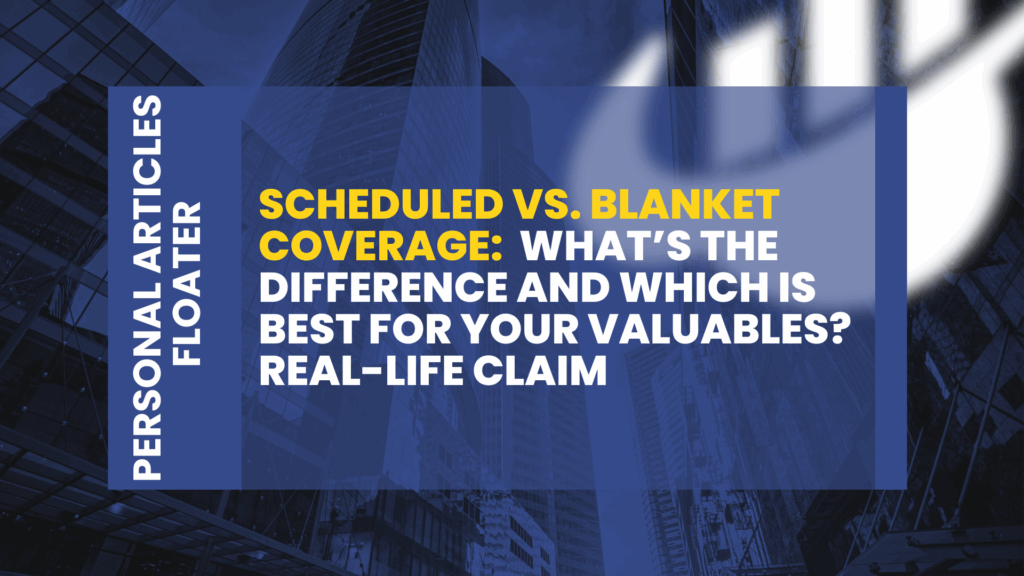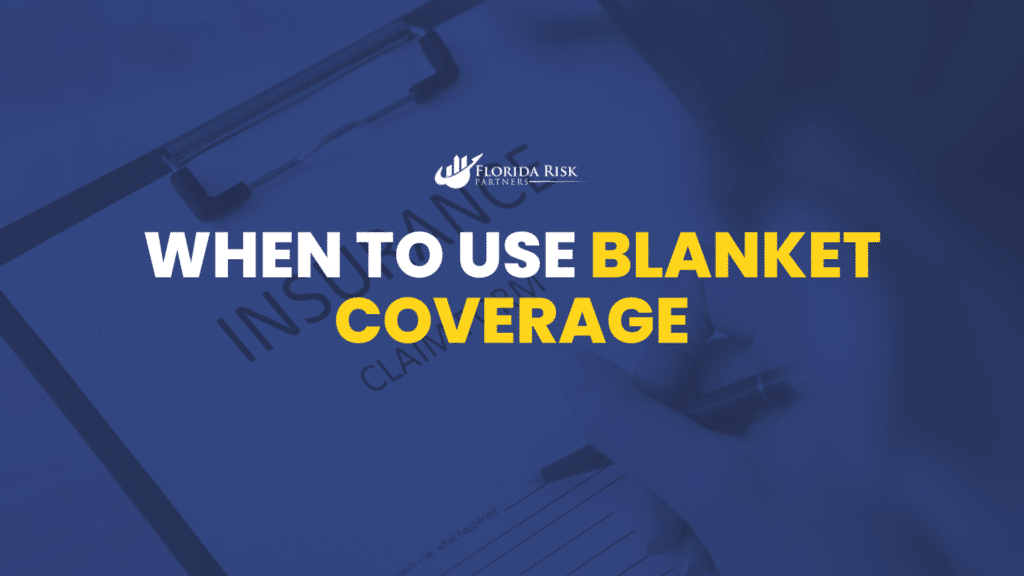-
Main Office: 1434 E. Bloomingdale Ave Valrico, FL 33596-6110
-
Phone: (888) 601-6660
-
Email: info@floridariskpartners.com

If you’ve been following our 12-week series on personal articles floaters, you already understand that your homeowners insurance may not fully protect your most valuable belongings. Items like jewelry, fine art, collectibles, instruments, and high-end electronics often require special treatment to be properly insured. That’s where personal articles coverage comes in.
But even within this type of coverage, there are two key ways to structure your protection: scheduled coverage and blanket coverage.
Understanding the differences between these two options—and when to use each—can help you get the right balance between protection, convenience, and cost. This week, we’ll break down what each type of coverage entails, the pros and cons of both, and how to decide which approach makes the most sense for your lifestyle and insurance needs.
Why Homeowners Insurance Alone Isn’t Enough
As a quick reminder, most standard homeowners insurance policies include Coverage C – Personal Property, which typically insures your belongings up to a percentage of your dwelling coverage—usually 50% to 70%. So, if your home is insured for $400,000, your policy may offer around $200,000 to $280,000 in personal property coverage.
However, this coverage has significant limitations for certain categories of items. For example:
- Jewelry theft may be limited to $1,500–$2,500
- Firearms may be capped at $2,000
- Silverware and collectibles often max out at $2,500 or less
- Coverage is typically based on actual cash value (i.e., depreciated value)
- Losses from mysterious disappearance, breakage, or accidental damage may be excluded
- There’s usually no worldwide protection for high-value items
To bridge these gaps, insurance carriers offer personal articles floaters—a form of inland marine insurance designed to insure valuable items either individually or as a group.
What Is Scheduled Coverage?
Scheduled personal property coverage means that you itemize and insure each valuable item individually. Each item is listed on your policy, with its own description, value, and often a supporting appraisal or receipt.
This approach is commonly used for high-value, unique, or sentimental items like:
- Engagement rings
- Fine art
- Musical instruments
- High-end watches
- Rare collectibles
- Firearms with significant value
- Antique furniture
- Designer handbags
How Scheduled Coverage Works
When you schedule an item, you and your insurer agree upon its insured value based on documentation like an appraisal, sales receipt, or valuation report. That value is used to determine your premium and is often paid in full in the event of a covered loss—no depreciation, no disputes.
Most scheduled items are insured on an open-perils basis, meaning unless the cause of loss is specifically excluded (e.g., war, nuclear hazard), the item is covered. Coverage often includes:
- Theft
- Accidental damage
- Fire
- Vandalism
- Mysterious disappearance
- Worldwide losses
Pros of Scheduled Coverage
- Full-value protection for each item
- No deductible in most cases
- Agreed value or replacement cost payout
- Customizable per-item limits
- Worldwide coverage often included
- Easier claims handling for documented items
Cons of Scheduled Coverage
- Requires detailed inventory
- May require professional appraisals
- Slightly more time-consuming to set up
- Higher premiums per item compared to blanket coverage
Scheduled coverage is best suited for individuals who own specific, high-value items that would be financially or emotionally difficult to replace.
What Is Blanket Coverage?

Blanket personal property coverage allows you to insure a group of similar items under one limit, without itemizing each piece. This type of coverage is ideal for those who own multiple mid-range valuables that may not require individual scheduling but still exceed the limits of a standard homeowners policy.
Blanket coverage is often used for:
- Jewelry collections with pieces under $2,500–$5,000 each
- Collectibles
- Smaller electronics
- Sporting or recreational equipment
- Cameras and photography gear
How Blanket Coverage Works
Instead of itemizing each item, you provide an estimated total value for a class of personal property. For example, you might insure your jewelry collection for $15,000 total under a blanket limit. Coverage is typically subject to a per-item maximum—for instance, $2,500 or $5,000 per item—so it’s important to ensure your most valuable items are still scheduled individually.
Blanket coverage is ideal for people who:
- Have a broad collection of similar items
- Want protection without going through appraisals
- Prefer a simplified, cost-effective solution
Pros of Blanket Coverage
- Easier and faster to set up
- No appraisals required for most items
- More affordable for lower- to mid-value collections
- Useful for people with many items of similar value
Cons of Blanket Coverage
- Per-item limits may not be high enough for individual valuables
- May not offer agreed value payouts
- Still requires documentation for claims handling
- Doesn’t cover uniquely valuable or irreplaceable items well
Side-by-Side Comparison
| Feature | Scheduled Coverage | Blanket Coverage |
| Itemization | Required per item | Not required (grouped by category) |
| Appraisals | Often required | Typically not required |
| Per-Item Limit | Customizable | Fixed per-item limit (e.g., $2,500) |
| Claims Payout | Agreed value or replacement cost | Actual cash value or capped amount |
| Deductible | Often $0 | May apply depending on policy terms |
| Best For | High-value, unique items | Moderate-value collections |
| Setup Time | Longer (requires documentation) | Faster, less paperwork |
When to Use Scheduled Coverage
You should strongly consider scheduling an item on your personal articles policy if:
- The item’s value exceeds your blanket coverage per-item limit
- The item has sentimental or emotional significance
- The item would be difficult or impossible to replace
- You have documentation of value (or can obtain it)
- You travel frequently with the item
- You want claims handled with minimal dispute or delay
Examples:
- A $12,000 diamond ring
- A $15,000 cello used in performances
- A $10,000 watch passed down from your grandfather
- A $6,000 antique rug from a trip abroad
When to Use Blanket Coverage

Blanket coverage is a great choice if:
- You own multiple items that are each under a certain value (e.g., <$2,500)
- You don’t want to deal with appraisals or itemization
- You want broad protection at a lower cost
- You’re insuring a growing or changing collection (like jewelry or photography gear)
Examples:
- A jewelry box with 15 pieces worth $500–$2,000 each
- A set of high-end golf clubs, mountain bike, and accessories
- A small collection of coins or rare books
- Multiple cameras and accessories used for hobby photography
Can You Combine Both Types?
Absolutely. In fact, many insurance professionals recommend a hybrid approach. You can schedule your most valuable or sentimental items individually and use blanket coverage for everything else. This ensures your most important belongings are fully protected, while still covering a wide range of lesser-valued items efficiently.
Example hybrid strategy:
- Scheduled coverage for engagement ring ($10,000) and antique violin ($7,500)
- Blanket coverage for general jewelry collection ($15,000 limit, $2,500 per item)
This layered approach offers the best of both worlds—maximum protection without excessive cost or complexity.
What Happens During a Claim?
If you’ve properly scheduled your items or set up blanket coverage, the claims process is generally straightforward. For scheduled items, the insurer refers to the value listed on your policy and issues a payout with minimal back-and-forth. For blanket items, the insurer may ask for:
- Proof of ownership
- Estimated or documented value
- Photos or purchase receipts
While appraisals aren’t typically required for blanket coverage, having some supporting documentation will speed up the claims process and improve your chances of full reimbursement.
Protecting What Matters Most
Regardless of which approach you choose, the key is to do something proactive now—before you face a loss. Too many people discover the shortcomings of their insurance only after the damage is done.
Here’s how to get started:
- Take inventory of your high-value items
- Estimate or appraise their value
- Identify which items exceed homeowners sublimits
- Determine what you can group under blanket coverage
- Schedule anything that requires special handling
And don’t forget to use our free downloadable checklist and inventory tool to guide you through the process.
Final Thoughts: Choosing the Right Coverage for You
Personal articles floaters are one of the most customizable and effective ways to protect your most valuable possessions. Whether you opt for scheduled, blanket, or a combination of both, the key is to make an informed choice based on your lifestyle, risk tolerance, and the true value of your belongings.
Insurance isn’t one-size-fits-all—and neither are the things we cherish most.
If you’re not sure which approach is right for you, we’re happy to help. Let us review your current coverage and work with you to build a plan that protects what matters.
Call Us Or
Schedule an Appointment
Select an agent below to view our online calendars and select a day and time that works best for you or call us directly at 888-601-6660. When you use our online calendars, you will receive an email with more information.



